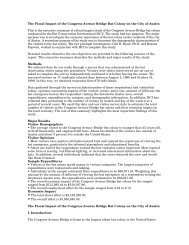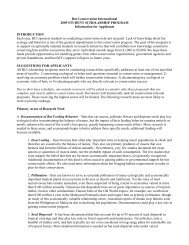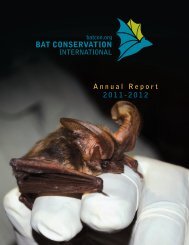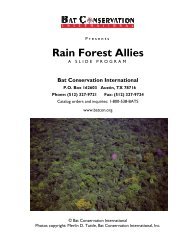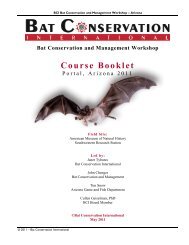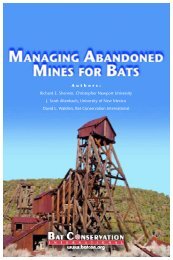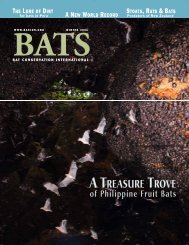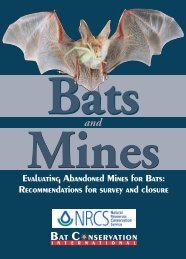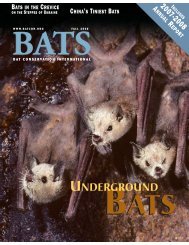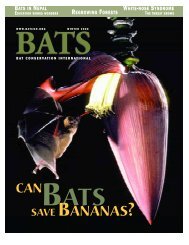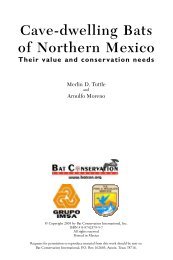Bat Echolocation Researc h - Bat Conservation International
Bat Echolocation Researc h - Bat Conservation International
Bat Echolocation Researc h - Bat Conservation International
You also want an ePaper? Increase the reach of your titles
YUMPU automatically turns print PDFs into web optimized ePapers that Google loves.
LITERATURE CITED<br />
Figure 5A: Pipistrellus pipistrellus has highest activity along stretches<br />
of river, which are smooth and have trees on both banks. 5B: Highest<br />
insect densities are recorded along river stretches that are smooth and<br />
tree-lined. Means + SDs are illustrated. Figure from Warren et al. (2000).<br />
with the best time-expansion detectors are important<br />
specifications for scientists interested in recording<br />
sounds from species that emit calls of low intensity<br />
and/or high frequency. Direct sampling overcomes<br />
problems of lost recording time. The increased information<br />
content of calls recorded by time expansion and<br />
direct sampling is also likely to result in better discrimination<br />
of species with similar call structure. For example,<br />
preliminary results suggest that Myotis species may be<br />
discriminated more confidently using time-expanded<br />
calls than by frequency-divided recording (L.P. Wickramasinghe,<br />
in litt.). Therefore direct sampling, with its<br />
advantages of high sensitivity and retention of maximal<br />
information content of calls, offers great benefits for<br />
future studies of habitat use by bats. In choosing bat<br />
detectors, trade-offs between recording quality and cost<br />
are inevitable (Fenton 2000), and the high quality<br />
offered by the recording techniques described in this<br />
paper may not be necessary for all studies of habitat use,<br />
although they are essential for describing the echolocation<br />
calls of bats (Fenton et al. 2001).<br />
BARCLAY, R. M. R. 1999. <strong>Bat</strong>s are not birds - a cautionary note<br />
on using echolocation calls to identify bats: a comment.<br />
Journal of Mammalogy 80:290-296.<br />
BARLOW, K. E. 1997. The diets of two phonic types of Pipistrellus<br />
pipistrellus (Chiroptera: Vespertilionidae) in Britain.<br />
Journal of Zoology (London) 243:597-609.<br />
BLONDEL, J., and J. ARONSON. 1999. Biology and wildlife of<br />
the Mediterranean Region. Oxford University Press,<br />
Oxford, United Kingdom.<br />
FENTON, M. B. 2000. Choosing the ‘correct’ bat detector. Acta<br />
Chiropterologica 2:215-224.<br />
FENTON, M. B., S. BOUCHARD, M. J. VONHOF, and J. ZIGOURIS.<br />
2001. Time-expansion and zero-crossing period<br />
meter systems present significantly different views of<br />
echolocation calls of bats. Journal of Mammalogy<br />
82:721-727.<br />
HAYES, J. P. 2000. Assumptions and practical considerations in<br />
the design and interpretation of echolocation-monitoring<br />
studies. Acta Chiropterologica 2:225-236.<br />
JONES, G. 1999. Scaling of echolocation call parameters in bats.<br />
Journal of Experimental Biology 202:3359-3367.<br />
JONES, G., and E. M. BARRATT. 1999. Vespertilio pipistrellus Schreber,<br />
1774 and V. pygmaeus Leach, 1825 (currently Pipistrellus<br />
pipistrellus and P. pygmaeus; Mammalia, Chiroptera):<br />
proposed designation of neotypes. Bulletin<br />
of Zoological Nomenclature 56:182-186.<br />
JONES, G., and S. M. VAN PARIJS. 1993. Bimodal echolocation<br />
in pipistrelle bats: are cryptic species present? Proceedings<br />
of the Royal Society of London B 251:119-<br />
125.<br />
JONES, G., N. VAUGHAN, and S. PARSONS. 2000. Acoustic identification<br />
of bats from directly sampled and time<br />
expanded recordings of vocalizations. Acta Chiropterologica<br />
2:155-170.<br />
KALKOUNIS, M. C., K. A. HOBSON, R. M. BRIGHAM, and K. R.<br />
HECKER. 1999. <strong>Bat</strong> activity in the boreal forest:<br />
importance of stand type and vertical strata. Journal<br />
of Mammalogy 80:673-682.<br />
KRUSIC, R. A., and C. D. NEEFUS. 1996. Habitat associations<br />
of bat species in the White Mountain National Forest.<br />
Pp 185-198 in <strong>Bat</strong>s and forests symposium,<br />
British Columbia Ministry of Forests, Victoria, British<br />
Columbia, Canada, Working Paper 23/1996.<br />
LANCE, R. F., B. BOLLICH, C. L. CALLAHAN, and P. L. LEBERG.<br />
1996. Surveying forest-bat communities with Anabat<br />
detectors. Pp. 175-184 in <strong>Bat</strong>s and forests symposium,<br />
British Columbia Ministry of Forests, Victoria,<br />
British Columbia, Canada, Working Paper 23/1996.<br />
MURRAY, K. L., E. R. BRITZKE, B. M. HADLEY, and L. W. ROB-<br />
BINS. 1999. Surveying bat communities: a comparison<br />
between mist nets and the Anabat II bat detector system.<br />
Acta Chiropterologica 1:105-112.<br />
88<br />
<strong>Bat</strong> <strong>Echolocation</strong> <strong>Researc</strong>h: tools, techniques & analysis



